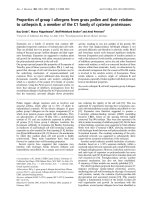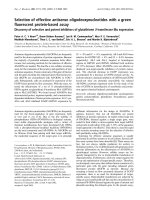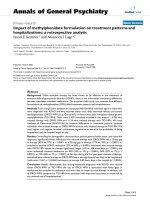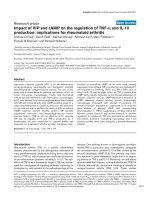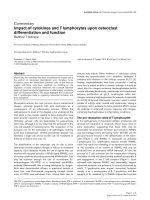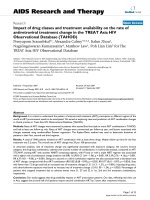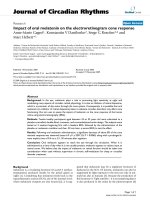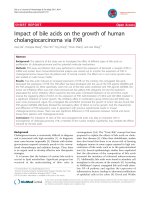Báo cáo y học: "Impact of the introduction of new vaccines and vaccine wastage rate on the cost-effectiveness of routine EPI: lessons from a descriptive study in a Cameroonian health district" potx
Bạn đang xem bản rút gọn của tài liệu. Xem và tải ngay bản đầy đủ của tài liệu tại đây (463.98 KB, 8 trang )
RESEARCH Open Access
Impact of the introduction of new vaccines and
vaccine wastage rate on the cost-effectiveness of
routine EPI: lessons from a descriptive study in a
Cameroonian health district
Cliford E Ebong
1*
and Pierre Levy
2
Abstract
The Expanded Program of Immunization (EPI) offers services to the population free of charge but these activities
are costly with the greatest part being the cost of vaccines. In spite of the growing international solidarity towards
funding for immunization, the growing objectives continue to outweigh the available resources. It is therefore
crucial for any immunization system to seek greater efficiency so as to optimize the use of available means in a bid
to ensure sustainability. It is in this light that we carried out this study which aims to assess the productive
efficiency of routine EPI for chi ldren aged 0 - 11 months with respect to the fixed and outreach vaccine delivery
strategies in Ngong health district. The study is descriptive and cross-sectional. Data were collected retrospectively
for all 16 health centers of the district that offered EPI services during the period February - May 2009.
The results show that:
• Only 62% of planned outreach immunization sessions were effectively carried out mainly due to limited funds for
transportation and staff availability. Consequently vaccine coverage was low (BCG: 70.1%, DPT-HB-Hib 3: 55.5%) and
less resources (43%) were used for this strategy which served 52% of the target population - a major blow to
equity.
• The average cost per Fully Immunized Child (FIC) was 9,571 FCFA (19.22 USD) for the fixed strategy; 12, 751 FCFA
(25.61 USD) for the outreach and 10,718 FCFA (21.53 USD) with both strategies combined. These figures are high
than those observed in many other African heal th districts. However, DPT-HB-Hib and yellow fever vaccines
contributed to the increase as vaccines occupied 57% of the total cost. With DPT in lieu of DPT-HB-Hib the cost/
FIC would be 6,046 FCFA (12.14 USD). Dropout rates too were high (28.1% for the fixed, 29.7% for outreach).
• The cost of vaccines wasted in excess of the national norm at the level of health centers was 595,532 FCFA
(1,196.15 USD), an amount that could cover the vaccine cost for 122 FIC (7.6% of the FIC during the period). This
was accounted for as follows: BCG 1.1%, OPV 1.4%, DPT-HB-Hib 72.7%, measles 5.3%, yellow fever 19.5%
• Therefore we suggest improved communication for EPI, the introduction of DPT-HB-Hib with liquid Hib and the
effective implementation of planned outreach sessions.
Keywords: EPI (Expanded Program of Immunization), cost-effectiveness, FIC (Fully Immunized Child), Excess vaccine
wastage, Pentavalent vaccine (DPT-HB-Hib), new vaccines, Camer oon, Ngong
* Correspondence:
1
Ngong District Health Service, Cameroon
Full list of author information is available at the end of the article
Ebong and Levy Cost Effectiveness and Resource Allocation 2011, 9:9
/>© 2011 Ebon g and Levy; licensee BioMed Central Ltd. This is an Open Access articl e distributed under the terms of the Creative
Commons Attribution License (http://creativeco mmons.org/licenses/by/2.0), which permits u nrestricted use, distribution, and
reproduction in any medium, pro vided the original work is properly cite d.
Background
Vaccines are costly and from many studies constitute a
major burden for every immunization program [1,2].
With the intr oduction of the GIVS (Global Immuniza-
tion, Vision and Strategy), immunization coverage objec-
tives have been raised to reach more children (equity)
and to cover more diseases. This involves the introduc-
tion of new vaccines and combinations which are gener-
ally more expensive. In this light, the Pentavalent
vaccine, DPT-HB-H ib was introduced (in place of DPT)
into the Expanded Program of Immunization (EPI) in
Cameroon in February 2009, alongside the other tradi-
tional vaccines BCG, OPV, Measles and yellow fever
(YF) vaccines.
The Ngong health district in the North region of
Cameroon (Figures 1 and 2) covers an area of 4,000 km
2
and served a total population of 143,238 in 2009, about
half of them cattle raisers. There are 5,730 target children
(aged 0-11 months) disseminated in 197 villages with an
annual average target of 36 ± 57 children per village. The
target for BCG (live births) was 6,446. Two vaccine deliv-
ery strategies are used for routine EPI: the fixed - at
health facilities - and the outreach - for those who l ive
more than 5 km from a health center (52%). The mobile
strategy (requires teams to go out to villages situated
farther than 20 km away with a vehicle and spend days to
serve many villages) is not used for logistical reasons
(most health centers do not even have a motorcycle) and
staff numbers are limited. So teams prefer to go out to
these villages by various means and return to the health
center at the end of the day.
Unfortunately, resources for immunization do not fol-
low proportionately the growing coverage objectives of
EPI and the GIVS (Global Immunization, Vision and
Strategy) in spite of the global solidarity towards funding
(GAVI, WHO, UNICEF, among others). This raises con-
cer ns about the long term sustainabi lity of the activities
of the program. Therefore, it is of the utmost impor-
tance to improve efficiency so as to rationally use the
available resources for the best possible results.
A health districts like Ngong with a large area and a
sparse and very mobile population dissemina ted in many
small villages, introduces both a high risk of vaccine
wastage and a high risk of dropout. Furthermore, the
top-down distribution of vaccines - from the central level
to the regions, then to each health district, and then to
health centers in proportion to approximate target popu-
lations - may worsen the direct impact of wastage on
HEALTH MAP OF THE NORTH REGION OF CAMEROON
•
•4
•6
•2
•5
•3
•8
•9
•7
•10
•12
•11
•13
Health Districts
•
1-
Mayo Oulo
•
2-Guider
•
3-Figuil
•
4-
Garoua Nord
•
5-Pitoa
•
6-Garoua
•
7-Bibémi
•
8-Ngong
•
9-Lagdo
•
10-Rey-
Bouba
•
11-Poli
•
12-Tcholliré
1
HEALTH MAP OF THE NORTH REGION OF CAMEROON
•
•4
•6
•2
•5
•3
•8
•9
•7
•10
•12
•11
•13
Health Districts
•
1-
Mayo Oulo
•
2-Guider
•
3-Figuil
•
4-
Garoua Nord
•
5-Pitoa
•
6-Garoua
•
7-Bibémi
•
8-Ngong
•
9-Lagdo
•
10-Rey-
Bouba
•
11-Poli
•
12-Tcholliré
1
Figure 1 The Map of the North region of Cameroon showing the health districts.
Ebong and Levy Cost Effectiveness and Resource Allocation 2011, 9:9
/>Page 2 of 8
coverage and efficiency. This is because the quantity of
vaccines is determined by the central level on the basis of
administrative target populations, coverage objectives,
wastage norms and a security margin. In a context of
high population mobility, the target population is hard to
master and va ccine wastage in excess of the national
norm drastically increases the risk of vaccine stock-outs.
This study aimed to assess the impact of the introduc-
tion of 2-dose lyophilized DPT-HB-Hib and of vaccine
wastage rate on the cost-effectiveness of EPI as well as
to identify main explaining factors of such results. The
primary objective of the study was to assess the produc-
tive efficiency of EPI for children aged 0-11 months
with respect to vaccine delive ry strategy - fixed and
Figure 2 The Map of Cameroon showing the ten regions.
Ebong and Levy Cost Effectiveness and Resource Allocation 2011, 9:9
/>Page 3 of 8
outreach - taking into account the differences between
the two strategies in terms of vaccine coverage and vac-
cine wastage. The secondary objectives were to estimate
the cost of excess vaccine wastage and to describe the
various mechanisms of vaccine wastage but also to
quantify the benefits of the open vial policy (reuse of
open liquid vaccines within four weeks in the absence of
contamination, expiration, Vaccine Vial Monitor color
change and exposure to light).
Materials and methods
This study was descriptive and cross-sectional. Data col-
lection was done retrospectively in July and August for the
period February to May 2009. All 16 health centers that
offered EPI services were st udied. Data on vaccine use
were obtained by exploitation of vaccine usage forms, vac-
cine movement registers and monthly EPI reports. Costs
for vaccines and consumables were estimated using the
UNICEF-WHO price projections [3]. The unit prices used
were 45 FCFA for BCG, 1 ,397 FCFA for Penta, 61 FCFA
for OPV, 88 FCFA for measles vaccine, 326 FCFA for
YFV, 38 FCFA for auto disable syringes, 60 FCFA for dilu-
tion syringes, and 299 FCFA for a safety box. The other
costs (personnel, transport , EPI running, Social mobiliza-
tion, short term training, maintenance, running the cold
chain, amortization for buildings, ‘rolling stock’, and refrig-
erators) were obtained by interview, direct surface mea-
surements of buildings, estimation of time spent for E PI
by the staff involved and the exploitation of various docu-
ments (immunization sessions plan, tally sheets, staff pay
vouchers, cash movement registers, receipts and building
reception documents) at the level of health centers and
the district health service.
The following shared health system costs were consid-
ered: personnel (generally polyvalent), buildings and the
rolling stock (motorcycles and the district truck). The
EPI cold chain was considered to be used 100% for the
program. Personnel costs were estimated by multiplying
their salary during the period by the proportion of their
time spent for EPI activities and then adding to it any
collation paid them. The activitie s considered include
vaccination sessions, transportation of vaccines, reporting
(immunization and disease surveillance), coordination
meetings, supervision, and cold chain temperature moni-
toring and maintenance. It was estimated that vaccina-
tion sessions and supervision take 4 hours each and
coordination meetings 8 hours.
Amortization costs for buildings, rolling stock and
cold chain ( refrigerators and the district deep freezer)
during the study period of 4 months were es timated by
dividing their respective costs by the amortization per-
iod - assumed 25 years for buildings and 5 years for
‘rolling stock’ and cold c hain. This was later divided by
3 (4 months/12) and then multiplied by the proportion
of use for EPI. Both time and space were considered for
buildings (number of days a week and proportion of
surface used). Time, space, and other resources spent
for activities n ot specific to either the fixed or outreach
strategy, were shared to the two according to target
population.
The data, collected on a data collection spreadsheet
made for the purpose, were analyzed with Excel software.
The main indicator of effectiveness was the number of
fully immunized children (FIC, children who received all
3 doses of DPT-HB-Hib) and the main indicator of effi-
ciency was the cost per FIC. The costs of the district
health serv ice were shared to the health centers by strat-
egy in proportion to target population covered. Other
indicators used are the average cost per dose used (total
costs/total doses used) and the average cost per do se
administered (t otal costs/total doses administe red - what
it takes to administer a dose). Costs are expressed in
local currency (FCFA) as well as in USD using an
exchange rate of 497.87 FCFA for 1 U SD (official WHO/
UN April 2009).
Results
1. Vaccine coverage
Only 62% of planned outreach vaccinat ion sessions were
effectively carried out against 95% for the fixed. Of 2,271
live births expected during the period, 2,258 doses of
BCG were administered thus reaching a coverage of
99.4%. Of 2,019 children aged 0 - 11 months expected
1,610 doses of Penta 3 (FIC) were administered - 1,029
by the fixed strategy against 581 by outreach. This gives a
79.8% coverage (Figures 3 and 4). Penta 1 coverage was
102.2% and the specific dropout rate (Penta 1 to Penta 3)
was 22.0%. Vaccine coverage above 100% is common. It
is calculated on the basis of administrative data which are
not usually up-to-date in this context of very rampant
human movement. It was generally higher for the fixed
strategy as compared to the outreach but the BCG -
Penta 3 dropout rates were very similar (figure 3).
2. EPI Costs
Recurrent costs made up for 92.2% of total EPI costs with
up to 61.1% for vaccines and consumables (table 1), 57%
for vaccines alone. This is even greater for the fixed
99.4%
131.1%
70.1%
79.8%
106.0%
55.5%
28.7%
28.1%
29.7%
0.0%
20.0%
40.0%
60.0%
80.0%
100.0%
120.0%
140.0%
Global
Fixed
Outreach
Dropout rate
Penta VC
BCG VC
Figure 3 Vaccination coverage for the district and dropout rate
for BCG - Penta 3.
Ebong and Levy Cost Effectiveness and Resource Allocation 2011, 9:9
/>Page 4 of 8
strategy. Penta vaccine accounted for 78% of the total
cost of vaccines and consumables (8,242,300 FCFA). This
is due to its high cost and the need for up to 3 doses per
FIC. Whereas personnel is known for being the largest
cost category, generally account ing for more than half of
the total cost [1,2], it accounts for only 21% of total cost
in the present study. In fact the government health staff
situation was so poor in Ngong health district that health
facilities resort to the use of unpaid or poorly paid staff.
This is further accentuated by a high cost for vaccines.
3. Efficiency of EPI in the District
The average cost/FIC was 9,571 F CFA (19.22 USD) for
the fixed strategy and 12,751 FCFA (25.61 USD) for the
outreach (figure 5). The global average cost/FIC fo r the
district was 10,718 FCFA (21.53 USD). Disaggregated
results show a 5-time variation among health centers,
ranging from 7,208 FCFA (14.48 USD) at Ngong to
36,101 FCFA (72.51 USD) at Bangli for the fixed strat-
egy (Table 2). The Boumedje health center that started
activity during the period ad that only implemented one
round of outreach in four months had a total cost of
163,641 FCFA (328.68 USD) for the ou treach strategy
and no FIC sinc e no dose of Penta 3 was administered.
With the cost of vaccines and consumables ignored, the
costperFICforthedistrictremainshigherwiththe
outreach strategy, and with the cost for DPT introduced
in lieu of Penta we notice a 77% increase due to Penta
(Table 3).
4. Vaccine wastage
The wastage rate was generally lower in the fixed strat-
egy except for OPV ( table 4). Whereas for traditional
antigens, such as BCG and OPV, the district wastage
rate was within the accepted range, this was not the
case for more expensive and newer vaccines, mainly
Penta and YFV. However it wa s much lower than p re-
viously reported in similar studies in other African
health districts [4-6]. An inquiry into the causes of
wastage showed that 98% of vaccine doses were lost
after the vial was opened as already noted in a previous
study in Benin [4]. No vaccines were lost at the district
level. One reason why OPV wastage is within accepted
range is that the open vial policy is applied in 9 of the
16 health centers and 72.8% of all open vials of OPV
and tetanus toxoid (for pregnant women) produced
were reused at least once, in line with previously pub-
lished results [4].
The values of vaccine doses wasted in excess of the
national norm (excess vaccine wastage) at individual
health centers sum up t o 301,264 FCFA (605.11 USD)
for the fixed strategy and 294,268 FCFA (591.05 USD)
for the outreach (Table 5). These two amounts equate
to the total cost for vaccines for 122 FIC (7.6% of FIC
during the period). The cost structure of this excess vac-
cine wastage was as follows: BCG 1.1%, VPO 1.4%,
Penta 72.7%, Measles 5.3%, YFV 19.5%. This clearly
shows that newer and much more expensive vaccines
such as Penta have a dramatic impact on the cost of
wastage and put to the forefront the need for a better
control and increased effectiveness of delivery services.
Figure 4 The Global (fixed + outreach) vaccine coverage for
BCG, Penta 1 and Penta 3 and specific dropout rate for Penta.
Table 1 EPI costs and their structure for the district
COST POST COST BY POST (F CFA) COST STRUCTURE
Fixed Outreach Global Fixed Outreach Global
VACCINES/CONSUMABLES 6,374,600 4,163,584 10,538,184 64.7% 56.2% 61.1%
TRANSPORT/FUEL 319,895 543,705 863,600 3.2% 7.3% 5.0%
MAINTENANCE 31,713 121,687 153,400 0.3% 1.6% 0.9%
SALARIES/COLLATIONS 2,108,912 1,529,536 3,638,448 21.4% 20.6% 21.1%
SOCIAL MOBILIZATION 17,800 34,330 52,130 0.2% 0.5% 0.3%
SHORT TERM TRAINING 11,542 12,458 24,000 0.1% 0.2% 0.1%
PROGRAMME RUNNING 55,256 41,874 97,130 0.6% 0.6% 0.6%
COLD CHAIN RUNNING 262,061 288,899 550,960 2.7% 3.9% 3.2%
AMORTIZATION 666,479 672,302 1,338,781 6.8% 9.1% 7.8%
TOTAL COST 9,848,259 7,408,374 17,256,633 100.0% 100.0% 100.0%
Ebong and Levy Cost Effectiveness and Resource Allocation 2011, 9:9
/>Page 5 of 8
Discussion
One of the main findings of this study is that vaccine
coverage is lower for the outreach strategy than for the
fixed while dropout rate is high for both strategies. Rea-
sons for such a result lie in inadequate sensitization,
high population mobility and low implementation of
planned outreach vaccination sessions, the latter being
due to limitations in funds generation or allocation at
the health center level for the transportation of teams.
The desire to moderate vaccine wastage in a setting
with numerous small villages where attendance at
immunization sessions is usually low creates missed
chances as staf fs often postpone the administration of
an antigen until more children are present. These are
missed chances. Nevertheless vaccine wastage was
higher than the national norm and the cost of excess
wastage amounted to the vaccine cost for 122 additional
FIC (7.6% of FIC during the study period). The most
important part of this excess cost was due to the loss of
newer, expensive vaccines (Penta and YFV). Whe reas
wastageoccursessentiallyaftertheopeningofvials
(98%), the correct application of the open vial policy in
a majority of health centers explains why OPV wastage
was contained within accepted limits for the district.
Concerning EPI costs, it appears that recurrent costs
are very predominant and are largely due to the cost of
vaccines (Penta, YFV). Personnel costs accounted for a
smaller part due to the use of unpaid staff and the
weight of vaccine costs. Moreover, training and sensiti-
zation/soci al mobilization represent negligible cost cate-
gories. This can explain the low coverage and high
dropout of the target population especially for the out-
reach stra tegy where fewer resources (43%) are used for
a greater portion of the population (52%).
As a consequence, the efficiency of EPI is suboptimal.
The average cost per FIC (USD 21,53) is greater than
figures obtained in other African health districts [7-9].
This could be partly due to methodological differences
concerning the estimation of personnel costs. The latter
are often restricted to incremental costs incurred by
outreach strategies ( perdiems or collation) and not the
full costs imputable to vaccination as in the present
study. Two main factors contributing to true suboptimal
efficiency are high dropout rates caused by inadequate
sensitization/social mobilization and a difficult demogra-
phy. But this re sult should also be viewed in the light of
the introduction of Penta, a more expensive vaccine.
These differences c ould explain why numerou s studies
across the world found an average cost per FIC which
was very variable depending on the country of interest
9,571
12,751
10,718
907
1 079
974
734
828
772
0
5,000
10,000
15,000
Fixed
Outreach
Global
Cost/dose used
Cost/dose administered
Cost per FIC
Figure 5 TheAveragecostperFIC,DoseAdministeredand
Dose Used in FCFA.
Table 2 Cost per fully immunized child by health center
and by vaccine delivery strategy after distributing
district service costs in proportion to target population
Health center Total cost (FCFA) Cost per FIC (FCFA)
Fixed Outreach Fixed Outreach
Bangli 252,706 280,968 36,101 14,048
Nakong 766,584 523,730 11,273 20,949
Djalingo 935,537 1,400,112 7,996 8,001
Babla 471,313 288,826 8,569 10,697
Kismatari 389,303 202,815 29,946 14,487
Djefatou 482,438 0 11,487 /
Karewa 236,879 140,397 12,467 10,800
L Tchitta 362,935 439,661 20,163 14,655
Ndjola 898,716 0 10,573 /
L Massa 528,625 427,479 9,974 8,724
Ngong 1,787,465 1,012,914 7,208 14,470
Boumedje 495,491 163,641 7,507 163,641/0
Tcheboa 688,132 430,507 8,822 18,718
S Ngal 564,169 0 7,836 /
Touroua p. 591,052 1,315,442 8,209 16,240
St Vincent 396,912 781,884 24,807 14,479
Total 9,848,259 7,408,374 9,571 12,751
Table 3 Cost per FIC for the district under special
considerations
Condition Cost per FIC
Fixed
strategy
Outreach
strategy
Global
With Penta 9,571 FCFA
(19.22 USD)
12,751 FCFA
(25.61 USD)
10,718 FCFA
(21.53 USD)
With DPT in lieu of
Penta
5,098 FCFA
(10.24 USD)
7,726 FCFA
(15.52 USD)
6,046 FCFA
(12.14 USD)
Vaccines and
consumables ignored
3,376 FCFA
(6.78 USD)
5,585 FCFA
(11.22 USD)
4,173 FCFA
(8.38 USD)
Table 4 Wastage rate by strategy and antigen for the
district of Ngong
Strategy Antigens
BCG PENTA OPV Measles YFV
Fixed 37.7% 6.8% 15.7% 27.2% 27.2%
Outreach 50.2% 7.1% 9.6% 38.8% 38.8%
Global 43.0% 6.9% 13.5% 32.6% 32.6%
National norm < 50% < 5% < 25% < 25% < 25%
Ebong and Levy Cost Effectiveness and Resource Allocation 2011, 9:9
/>Page 6 of 8
and the reference year. Studies conducted during the
1980s found a range from USD 5 to USD 15 per FIC
while later studies found a range from USD 10 to USD
20 and even higher [10,11].
The 5-time variation in cost per FIC amongst health
centers can be analyzed as follows. The c ost per FIC is
lowest in Ngong and Djalingo that serve dense semi-
urban populations and that have high numbers of FIC, a
major determinant of cost per FIC [12]. In contrast, in
Bangli where for about the same fixed costs coverage is
low and dropout high because of poor general use of
the health center, the cost per FIC is 5-times higher for
the fixed strategy. Just one nurse serves in this health
center and the nearby population, in addition to being
rural (with low literacy rate) and requiring even more
sensitization, has a reputation of being very exigent.
Vaccine wastage in excess of the national norm is
highest for penta. This may signify that due to its high
cost, an overambitious threshold level of wastage (5%)
was set. When the health centers are considered indivi-
dually, even antigens with a normal wastage rate at the
district level have excess wastage.
Conclusions
- Efficiency of EPI is lower with th e outreach strat-
egy in Ngong health district because of poor imple-
mentation of planned immunization sessions, a
difficult population settlemen t situation and inade-
quate social mobilization. However, the strategy
needs to be reinforced as it improves equity and
reduces indirect costs of immunization incurred by
mothers who live in distant localities.
- There is a 5-time variation in cost per FIC amongst
health centers, mainly due to low coverage and high
dropout in poorly used health centers with less dense
population. This projects the role of the number of
FIC in determining the cost per FIC
- Excess vaccine wastage has a high cost when
expensive vaccines are used, especially if the open
vial policy cannot be applied as with lyophilized Hib
vaccine, hence the need to resort to a presentation
with liquid Hib. This would encourage vaccination
staff to readily open a vial to immunize a child at
every opportunity, given that the co-administered
vaccine, OPV, is also liquid and the open vial policy
applies.
Abbreviations used
BCG: Bacille Calmette-Guerrin; DPT: Diphtheria, pertussis and tetanus vaccine;
DPT-HB-Hib: Diphtheria, pertussis, tetanus, hepatitis B and Haemophilus
influenza type b vaccine (Pentavalent vaccine or Penta); EPI: Expanded
Program of Immunization; EPIVAC: Epidemiology, Vaccinology, and
Management program; FCFA: African Franc, FIC: Fully Immunized Child; GIVS:
Global Immunization, Vision and Strategy; OPV: Oral Poliomyelitis Vaccine, UN:
The United Nations; UNICEF: United Nations International Children’s
Emergency Fond; USD: United States Dollar; WHO: The World Health
Organization;, YFV: Yellow fever vaccine
Acknowledgements and Funding
We seize this opportunity to thank all those who in one way or the other
contributed to the completion of this study. Our special thanks go to the
following:
- The chiefs of center of all the health centers that participated in this study
and the entire district management team of the Ngong health district. Their
time, energy and logistic support were of the utmost importance
- The EPIVAC training/action program for technical and financial support
- Dr Jean Thomas Bikoi of the EPI central team in Yaounde and supervisor of
the EPIVAC program for support during the initial write-up
Author details
1
Ngong District Health Service, Cameroon.
2
Université Paris Dauphine, LEDa-
LEGOS, France.
Authors’ contributions
CEE Conceived the study and performed the initial study design, the data
collection and analysis and the initial write-up
PL revised the study design, ensured the supervision, did the final
corrections of the manuscript
Both authors read and approved the final manuscript
Authors’ information
C.E.E.: MD, DIU 3
e
cycle Management/applied vaccinology (EPIVAC)
District Medical Officer, Ngong, Cameroon, e-mail: http://cliffebong@yahoo.
com
P. L.: PhD in Economics
Assistant Professor, Université Paris Dauphine, LEDa-LEGOS, France, e-mail:
http://
Competing interests
The authors declare that they have no competing interests.
Received: 18 November 2010 Accepted: 28 May 2011
Published: 28 May 2011
Table 5 Sum total of excess wastage at individual health center level and by delivery strategy
Antigen Accepted wastage rate Excess wastage (doses) Cost of excess wastage
Fixed Outreach Fixed Outreach Global Percentage
BCG 50% 148 0 6,660 0 6,660 1.1
OPV 25% 121 17 7,381 1,037 8,418 1.4
Penta 5% 165 145 230,505 202,565 433,070 72.7
Measles 25% 137 219 12,056 19,272 31,328 5.3
YFV 25% 137 219 44,662 71,394 116,056 19.5
Total 708 600 301,264 294,268 595,532 100
Ebong and Levy Cost Effectiveness and Resource Allocation 2011, 9:9
/>Page 7 of 8
References
1. Kaddar M, Levin A, Dougherty L, Maceira D: Costs and Financing of
Immunization Programs: Findings from Four Case Studies Special Initiatives
Report 26. Bethesda, MD: Partnerships for Health Reform Project, Abt
Associates Inc; 2000.
2. WHO: Economics of immunization: a guide to the literature and other
resources Department of Immunization, Vaccines and Biologicals, WHO:
Geneva; 2004.
3. Lara JW, François G, Shook-Pui LM, Patrick L, Ahmed M, Abdelmajid T,
Benjamin J, Raymond H, Peter S, Jean-Marie O-B: Estimating the costs of
achieving the WHO-UNICEF Global Immunization Vision and Strategy
2006-2015. Bull of the WHO 2008, 86(1):27-39.
4. Lévy P, Abdou Garda M, Agossa A, Barry A, Guezo-Mevo B, Khouma M,
Kora G: Taux de perte en vaccins et efficience du Programme élargi de
vaccination: où en est-on dans les districts sanitaires africains? Bulletin de
la Société de Pathologie Exotique 2009, 102(1):69-71.
5. Belemvire S: Etude des taux de perte en vaccins et impact sur l’efficience
du PEV dans le district sanitaire de Bogandé de 2001 à 2003. Bulletin de
la Société de Pathologie Exotique 2005, 98(5):415.
6. Teme S: Taux de perte en vaccins dans le Cercle de Kadiolo, en 2003 au
Mali. Bulletin de la Société de Pathologie Exotique 2005, 98(5):423-424.
7. Bete FH, Lévy P: Estimation et analyse des coûts du PEV de routine en
2003 dans la Zone Sanitaire de Bassila, Bénin - Contribution à
l’efficience du programme. Bulletin de la Société de Pathologie Exotique
2005, 98(5):415-416.
8. Hessou PSH, Lévy P: Estimation et analyse des coûts de la vaccination de
routine (PEV) dans la Zone Sanitaire Djidja-Abomey-Agbangnizoun en
2003, Bénin - Quelle approche pour la pérennisation? Bulletin de la
Société de Pathologie Exotique 2005, 98(5):418.
9. Sow Sall D, Lévy P: Analyse des coûts du Programme élargi de
vaccination (PEV) dans le District Sanitaire de Thiès, Sénégal. Bulletin de
la Société de Pathologie Exotique 2005, 98(5):423.
10. Kaddar M, Tanzi V, Dougherty L: Case Study on the Costs and Financing of
Immunization Services in Côte d’Ivoire Special Initiatives Report 24. Bethesda,
MD: Partnerships for Health Reform, Project, Abt Associates Inc; 2000.
11. Khaleghian P: Immunization Financing and Sustainability: A Review of the
Literature Special Initiatives Report No. 40. Bethesda, MD: Partnerships for
Health Reform Project, Abt Associates Inc; 2001.
12. Phonboon K, Shepard DS, Ramaboot S, Kunasol P, Preuksaraj S: The Thai
expanded programme on immunization: role of immunization sessions
and their cost-effectiveness. Bull World Health Organ 1989, 67(2):181-188.
doi:10.1186/1478-7547-9-9
Cite this article as: Ebong and Levy: Impact of the introduction of new
vaccines and vaccine wastage rate on the cost-effectiveness of routine
EPI: lessons from a descriptive study in a Cameroonian health district.
Cost Effectiveness and Resource Allocation 2011 9:9.
Submit your next manuscript to BioMed Central
and take full advantage of:
• Convenient online submission
• Thorough peer review
• No space constraints or color figure charges
• Immediate publication on acceptance
• Inclusion in PubMed, CAS, Scopus and Google Scholar
• Research which is freely available for redistribution
Submit your manuscript at
www.biomedcentral.com/submit
Ebong and Levy Cost Effectiveness and Resource Allocation 2011, 9:9
/>Page 8 of 8
